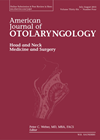
Journal Reviews
CT parameters in orbital wall fractures, choice of treatment, and patient outcome
This review from the Netherlands attempts to evaluate the relationship between CT parameters and the treatment that is used in clinical outcome (enophthalmos, diplopia and/or limitation in ocular movement). The authors look at fracture size, fracture location and involvement of...
Can diet alone be used to treat laryngopharyngeal reflux?
In this crossover observational study, a low-fat, low-quick-release sugar, high-protein, alkaline, and plant-based diet was investigated as a single treatment for laryngopharyngeal reflux (LPR). Authors recruited 50 participants with demonstrated LPR on hypopharyngeal-oesophageal multichannel intraluminal impedance-pH-monitoring (HEMII-pH), off acid suppressive...
Should we be utilising the pre-lacrimal approach for maxillary sinus inverted papilloma?
For some time now, gold standard management of the maxillary sinus inverted papilloma has been endoscopic medial maxillectomy (EMM). Recently the endoscopic prelacrimal recess approach (EPLRA) has been reported to provide good access whilst preserving the nasolacrimal duct and inferior...
Coblation for laryngeal granulomas
Laryngeal granulomas remain notorious for their tendency to recur after surgical removal. Although high rates of complete remission have been reported with use of the potassium-titanyl-phosphate (KTP) laser, this equipment is expensive and not available in all units performing ENT...
Endovascular therapies for venous tinnitus
Tinnitus is an extremely vexing issue, not only for patients but also for otolaryngologists. The authors of this article review the causes of venous tinnitus, such as increased intracranial hypertension (IIH), dural venous sinus thrombosis and age-related anatomic variants. They...
British Skull Base Society Clinical Consensus Document on Management of Head and Neck Paragangliomas (HNPGLs)
All forms of HNPGLs should be managed by a multidisciplinary team (MDT) of core members from skull base otolaryngology, head and neck surgery, clinical genetics, oncology, endocrinology, vascular surgery, radiology and pathology. Extended members include neurosurgery, endocrine surgery, nuclear medicine,...
Delays in oral cancer
This is a review from Canada where they attempt to relate delays in oral cancer presentation to treatment and the impact on stage, diagnosis and survival. They recognise that potentially the most significant delay is between the patient first noticing...
Socially appropriate part II: therapy for people with TBI
Social communication is a complex behaviour comprising social and cognitive communication skills. Providing speech and language therapy (SLT) interventions for people with social communication difficulties following traumatic brain injury (TBI) requires the clinician to understand how ingredients from an evidence-based...
Bamboo nodes – a case series
Bamboo nodes are band-like, cream-coloured submucosal deposits affecting the middle third of the vocal cord. They are reported to affect women exclusively and are frequently bilateral but can be asymmetrical. They are distinct from vocal cord nodules but can be...
Long-term voice outcomes following transoral laser surgery versus radiotherapy for early laryngeal cancers
The oncological outcomes of transoral laser microsurgery (TOLM) for early laryngeal cancers are well-known to be very similar to radiation therapy (RT). The functional outcomes associated with each treatment modality are therefore of significant interest. This study is reported to...
A single blinded RCT comparing triamcinolone with 5-FU treatment for keloid scars
This single blinded RCT compared 43 patients with 50 symptomatic keloids that were randomised to two matched groups of 25 scars, receiving either 5-fluorouracil (5-FU) or current first line treatment, triamcinolone (TAC). The surgeon administering the injectable treatments was unblinded,...
Does surgery work for acquired stenosis of the ear canal in the long term?
The surgical treatment of acquired post-inflammatory atresia of the external auditory canal (EAC), namely meatoplasty, is challenging with variable long-term outcome. This study looked at the clinical, audiological data, long-term outcome and patient satisfaction after performing meatoplasty. Sixteen patients were...

















